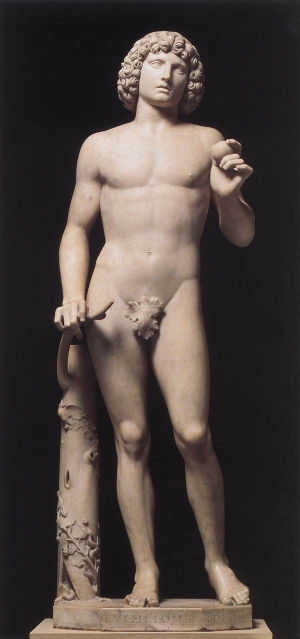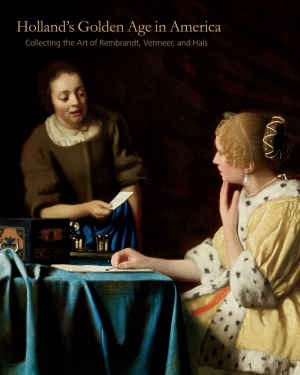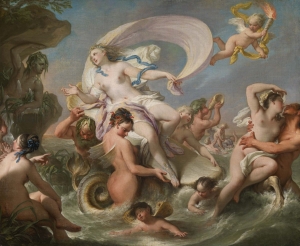|
Displaying items by tag: Italian Renaissance
The Isabella Stewart Gardner Museum in Boston will be the sole venue for the first ever monographic exhibition dedicated to Carlo Crivelli in the United States. Titled, Ornament and Illusion: Carlo Crivelli of Venice, the exhibition opens Oct. 22 and runs through Jan. 25, 2016.
Carlo Crivelli (about 1435–about 1495) is one of the most important – and historically neglected – artists of the Italian Renaissance. Distinguished by radically expressive compositions, luxuriant ornamental display, and bravura illusionism, his works push the boundaries between painting and sculpture.
A 12-year-old boy had the worst museum visit ever this past Sunday, at Taipei's Huashan 1914 Creative Park. The boy tripped and punched a Paolo Porpora painting valued at $1.5 million as he was trying to keep his balance.
According to Focus Taiwan, the boy was with a guided tour group visiting the exhibition "The Face of Leonardo, Images of a Genius," which gathers 55 paintings by key artists starting from the Italian Renaissance and going up to the 20th century.
A rare early Italian Renaissance painting that has never been exhibited in public before has been gifted to the National Gallery, and has gone on display. "Christ Carrying The Cross" has been presented to the National Gallery by Angus Neill, a loyal supporter of the Gallery.
“For many years, regular visits to the National Gallery have given me great pleasure. I hope that this gift goes some way to thanking the Gallery for all that it - and its collection - have done for me” stated Neill.
The Gemäldegalerie in Berlin and London's Victoria and Albert Museum have joined forces to present a comprehensive exhibition of works by the early Renaissance master Sandro Botticelli, "Monopol" reports.
Botticelli is not only regarded as one of the leading painters of the Italian Renaissance, but also as an icon of pop culture. The exhibition, thus, will pay tribute to the artist's enduring influence on art, design, and fashion, which can be traced to the present day.
In our era of rapid prototyping and 3D printing, technologies that promise to transform the production of everything from medical devices to skyscrapers, it is easy to lose sight of how three-dimensional objects came into being in the predigital age. One way into this question is through drawing. What role did it play in the production of Renaissance sculpture, some of the most ambitious and technically accomplished ever produced? Or, as Columbia University art historian Michael Cole puts it, “Why did sculptors draw?”
his is the problem at the center of “Donatello, Michelangelo, Cellini: Sculptors’ Drawings from Renaissance Italy,” currently on view at the Isabella Stewart Gardner Museum in Boston and co-curated by Mr. Cole and Oliver Tostmann, formerly of the Gardner and now Curator of European Art at the Wadsworth Atheneum in Hartford, Conn.

The Metropolitan Museum of Art’s marble sculpture "Adam" by Tullio Lombardo (ca. 1455–1532) will return to public view on November 11, following a tragic accident in 2002 and an unprecedented 12-year conservation project. It is the first life-sized nude marble statue since antiquity and the most important Italian Renaissance sculpture in North America. Tullio carved Adam in the early 1490s for the monumental tomb of doge Andrea Vendramin, now in the church of Santi Giovanni e Paolo, Venice, and it is the only signed sculpture from that iconic monument. The sculpture and its restoration will be the focus of Tullio Lombardo’s "Adam: A Masterpiece Restored," the inaugural installation in the Museum’s new Venetian Sculpture Gallery.
Thomas P. Campbell, Director and CEO of the Metropolitan Museum, said: “We are proud to return this great Tullio sculpture to public view in a beautiful new gallery. Our extraordinary conservators collaborated with a team of experts over 12 years to pursue this extremely challenging work. The results of their care and innovation are stunning.”

The Frick’s Center for the History of Collecting announces a new book series with the publication of its first volume, "Holland’s Golden Age in America: Collecting the Art of Rembrandt, Vermeer, and Hals." This series, entitled The Frick Collection Studies in the History of Collecting, is co-published with the Pennsylvania State University Press, and will ultimately cover a broad range of art collecting, reflecting the Center's reach well beyond the parameters of the Frick's own scope to include topics on modern and non-western art. Comments Inge Reist, Director of the Center, “We aim to encourage new scholarship in this young field of art history through our annual acclaimed symposia and ongoing fellowship program, much of which leads to new publications. Complementing that activity is this series that enables the Center to make its own contribution to the growing bibliography on the history of collecting in America.” This and future volumes are drawn from papers given at the Center’s symposia. Upcoming books from recent events include "A Market for Merchant Princes: Collecting Italian Renaissance Painting in America" (February 2015), edited by Inge Reist; "Going for Baroque: Americans Collect Italian Paintings of the 17th and 18th Centuries," edited by Edgar Peters Bowron; and "The Americas Revealed: Collecting Colonial and Modern Latin American Art in the United States," edited by Edward Sullivan.
Americans have long had an interest in the art and culture of Holland’s Golden Age. As a result, the United States can boast extraordinary holdings of Dutch paintings. Celebrated masters such as Rembrandt, Johannes Vermeer, and Frans Hals are exceptionally well represented in museums and private collections, but many fine paintings by their contemporaries can be found here as well.

A traveling exhibition of master paintings by some of the greatest names in European art ends its East Coast summer residency at the Allentown Art Museum on Sunday, September 7. "Of Heaven and Earth: 500 Years of Italian Painting from Glasgow Museums" features works by Italian Renaissance and Baroque masters such as Giovanni Bellini, Sandro Botticelli, Francesco Guardi, Salvator Rosa, and Titian, many of which have never before been exhibited in the United States. This is a once-in-a-lifetime opportunity to see these forty major works; after Allentown, the exhibition will travel west to the Milwaukee Art Museum and the Santa Barbara Museum of Art.
Thanks to a generous grant from the Society of the Arts (SOTA), the exhibition is free to all visitors, Wednesday-Saturday 11-4 and Sunday noon-4. “The elimination of our admission fees this summer, and dual-language labels in English and Spanish, are intended to deliver a message that in this, our eightieth anniversary year, the Allentown Art Museum is accessible to all and that we encourage everyone to experience what this extraordinary institution has to offer,” says David Mickenberg, Priscilla Payne Hurd President and CEO of the Art Museum.
Private equity titan Leon Black and his wife Debra, a Broadway producer, melanoma survivor and leading force behind the Melanoma Research Alliance, are buying 19 E. 70th St., the former Knoedler & Company art gallery, which shuttered following a major art fraud scandal in 2009 that is still under investigation.
London developer Christian Candy bought the 30-foot-wide, 17,000-square-foot, 104-year-old Italian Renaissance-style townhouse for $35 million in 2013.
Artists can be eccentric, but the quirks of the Italian Renaissance master Piero di Cosimo are legendary. He is said to have been terrified of thunderstorms and so pyrophobic that he rarely cooked his food, subsisting mostly on hard-boiled eggs that he prepared 50 at a time while heating glue for his art. He didn’t clean his studio. He didn’t trim the trees in his orchard. Giorgio Vasari, the Renaissance biographer, described Piero as living “more like a beast than a man.”
He was a versatile artist, however. Painting mostly on panel in impeccable detail, he depicted religious subjects as well as mythological scenes. Many of his works remain in the churches for which they were painted in central Italy; others, made for prominent families in Renaissance Florence, are now in the permanent collections of American museums.
|
|
|
|
|